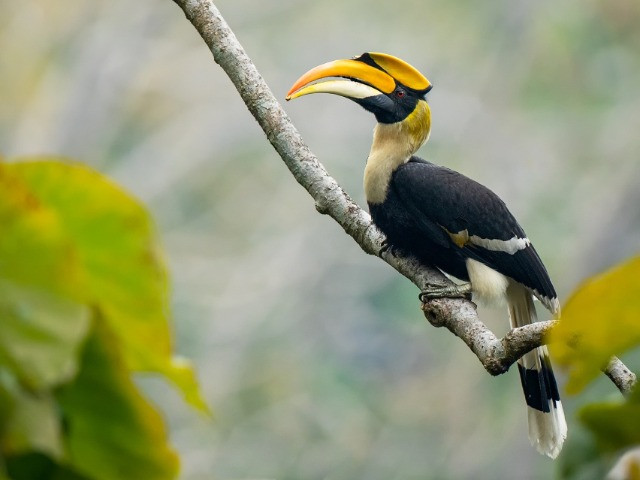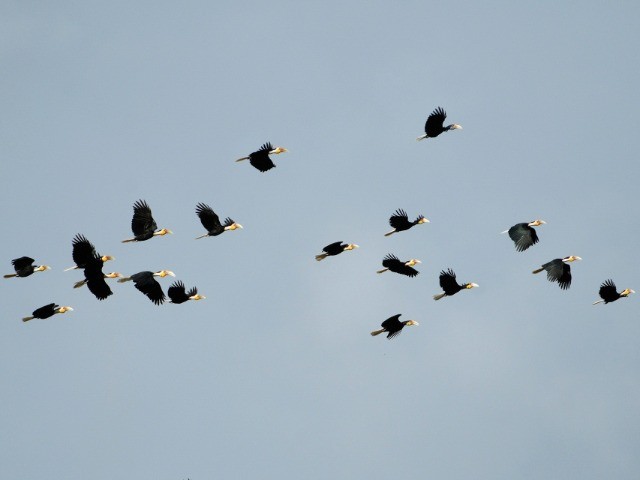The lush green canopy of the tropical forests with tall towering trees is the ideal habitat for the Great Hornbill – the largest among Asian hornbills. The distribution of this species spans from across the tropical forests of Southeast Asia till its westernmost limit in the Western Ghats of the Indian peninsula. Hornbills are large-bodied, wide-ranging birds and are secondary-cavity nesters – nesting in tree cavities made by other birds. They are mainly frugivorous (fruit-eating) birds and play a crucial role in seed dispersal, hence also known as ‘farmers of the tropical forest’.
The loss of forests throughout its distribution due to the expansion of agriculture, commercial plantations and logging, coupled with hunting, are the two major threats impacting the survival of this species. With the pace at which its natural habitats are shrinking, hornbills have been frequenting plantations and disturbed areas which were once their homes. Being such specialist birds, I was curious to understand how hornbills were responding to modifications in their habitats – whether they are behaving differently, changing their feeding habits or are breeding successfully in newer places than their natural habitats, etc.
I decided to study hornbill behaviour in a place called Valparai and its surrounding rainforests, which is a part of the Western Ghats in the state of Tamil Nadu. Until the colonial era, the scenic plateau of Valparai in the Anaimalai Hills was an array of dense rainforests with wildlife roaming freely and tribes living in harmony with nature. During the colonial era, the thickets of rainforests were chopped down to grow commercially important crops like tea, coffee and cardamom.
Today, Valparai is an area of 220sq.km. which lies in the heart of a larger network of protected areas in the Anamalai Hills. It shares borders with the Anaimalai Tiger Reserve, Parambikulam Tiger Reserve and Vazhachal Reserved Forest. Though, dominated by tea and coffee plantations, Valparai has nearly 40 rainforest fragments of varying sizes ranging from 0.3 to 300ha, which facilitates the movement of wildlife between its mosaic of plantations and surrounding protected areas.
Hornbills have very unique breeding and nesting habits. Hornbill pairs mate for life, and the female seals herself in the nest-cavity for months at a stretch during which the male provides food for the mother and the growing chick inside the nest. Hornbills also tend to use the same nest year after year.
You may also like to read
Along with my Kadar (a tribe native to the Anamalai Hills) field guides, Moorthy and Manikaraj, I walked under the thick canopy of Valparai’s rainforests and scouted its numerous coffee plantations to try and locate Great Hornbill nests. Following hornbill pairs during their courtship periods would lead us to their nests, and most of the nests we found in the coffee plantations were known to people previously. I observed three nests in the tiger reserve and five in the coffee plantations and rainforest fragments.
In the tiger reserve, hornbill nests were found in trees with massive girths of about seven meters. Due to the lack of such huge trees in coffee plantations, hornbills were found to be using hollows in smaller trees that were just three meters in girth. I also found a pair nesting in a Silver Oak tree – a non-native tree species in the plantations. As cavities are generally limited, the use of cavities in smaller trees, even that of non-native species, showed the first signs of hornbill’s response to their altered habitat.
After about eight months of following these majestic birds and observing them for more than 500 hours, I was able to get a sneak peek into their breeding habits such as courtship rituals, pair formation and other activities during nesting.
Hornbill pairs are formed after mid-air acrobatics called ‘casque-butting’ between young competing males. The winner male presents delicious fruits including figs to the female and the pair then spends time away from the larger flock in search of a cavity to nest in. Once a large-enough and suitable cavity is found, the pair monitors the area for over a week and if they find the cavity to be safe, they clean it a few times before the female enters the nest. After entering the nest, the female hornbill starts plastering the opening of the cavity using faeces, marking the beginning of the nesting season. She leaves only a small vertical slit open for the exchange of food and to throw away faecal waste and seeds from the nest.
Once the nesting began, I would observe the nest from early morning till the afternoon – keeping a note of the time when the male hornbill visited the nest and for how long, what and how many fruits or insects or small animals he brought for the mother seated inside, among other details. After about four weeks from the commencement of nesting, the silence in the nest was broken by the shrill calls of a baby hornbill.
Prior to the hatching of eggs, male hornbills would bring juicy fruits of various kinds – more often than not, crunchy insects and other animal matter. Once the chick hatches from the egg, the quantity of animal matter in their diet increases to foster the growth of the young one. I recorded 20 different species of fruits that included several species of figs, wild nutmegs and its relatives, and some juicy, sugary ones.
Maesopsis eminii is an African-origin tree species that was brought to Valparai as a shade-tree for coffee plants. These jamun-like fruits that belonged to Ziziphus family were eaten by all hornbills in the plantations, giving us a second clue to their adaptability, their flexibility to the local availability of fruits. In a single visit, the number of fruits delivered ranged from a couple to numbers in the hundreds. The highest I counted was 468 figs regurgitated by the male! I was also thrilled to have recorded thirteen different kinds of animals in their diet, including rodents, lizards, snakes, insects and young birds too! The nesting period of these Great Hornbills lasted for just about four months, all chicks fledged successfully, except for one from the plantations.
In the Valparai plateau, many coffee plantations have retained relatively large and tall trees which hornbills are using for roosting and nesting. And, most of the figs planted in plantations serve the dual purpose of providing shade to the coffee plants and of providing fruits for hornbills and other animals like the Malabar Giant Squirrel and Lion-tailed Macaque. These remnants of the rainforests in Valparai are possibly acting as stepping stones for hornbills to persist in such a plantation-dominated landscape.
In the face of such rapid loss of wilderness in our country, places like Valparai give us hope that if we retain the critical resources for animals such as hornbills, plantations could also become their home with some degree of adaptation. Different plantations may have varying conservation values; hence strategic planning and the choice of the crop would be crucial in determining the fate of wildlife in such modifications. With continued support from local stakeholders like private plantation companies, state forest department and local communities, I am hopeful that hornbills will continue soaring, whooshing and cackling over the canopies of Valparai in the coming years.








